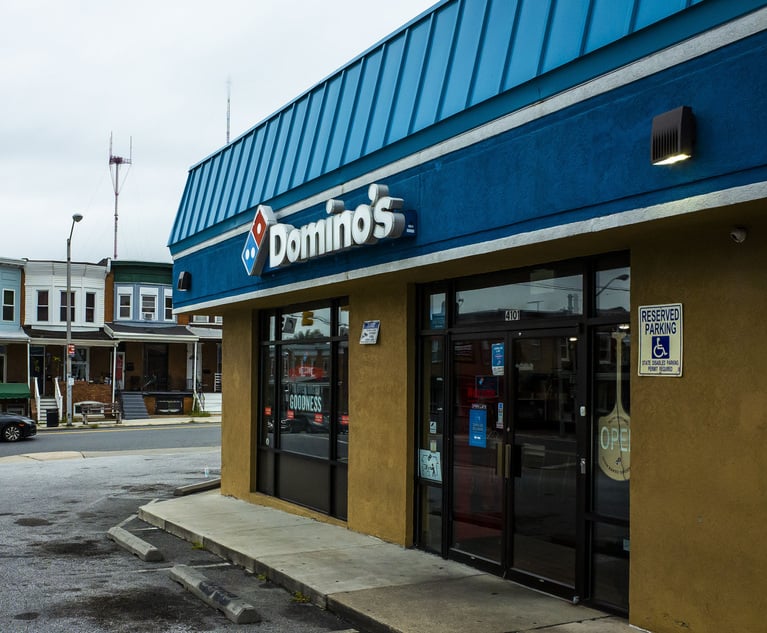In First-Impression Ruling, Court Assigns Pa. Sexual Violence Law 6-Year Statute of Limitations
Acknowledging that the state's Protection of Victims of Sexual Violence or Intimidation Act does not specify a time limit for filing an action seeking a protection order and noting that no Pennsylvania court has yet addressed the issue, the Pennsylvania Superior Court has ruled that the six-year catchall statute of limitations applies.
February 06, 2020 at 01:20 PM
3 minute read
 Credit: Min C. Chiu/Shutterstock.com
Credit: Min C. Chiu/Shutterstock.com
Acknowledging that the state's Protection of Victims of Sexual Violence or Intimidation Act does not specify a time limit for filing an action seeking a protection order and noting that no Pennsylvania court has yet addressed the issue, the Pennsylvania Superior Court has ruled that the six-year catchall statute of limitations applies.
In a precedential Jan. 30 opinion K.N.B. v. M.D., a unanimous three-judge panel of the appellate court upheld a protection order issued under the PVSVIA by a Clarion County Court of Common Pleas judge.
Plaintiff K.N.B. sought the sexual violence protection order against defendant M.D. after an alleged sexual assault that took place while they were both students at Clarion University, according to the court's ruling. M.D. had sought to vacate the order, arguing that K.N.B.'s action was time-barred because it was filed more than two years after the alleged assault.
To support his argument, M.D. pointed to subsection 5524(1) of the PVSVIA, which establishes a two-year statute of limitations for "'an action for assault, battery, false imprisonment, false arrest, malicious prosecution or malicious abuse of process.'" M.D. said that subsection applied because K.N.B. alleged she was a victim of sexual battery.
But Judge Maria McLaughlin disagreed, saying, "the PVSVIA does not provide victims of sexual violence with a cause of action for tortious conduct."
"It requires merely the assertion of tortious conduct," McLaughlin said. "Further, unlike the actions mentioned in Section 5524(1), in which a plaintiff seeks compensation for past harm, the intent of the PVSVIA is to protect the petitioner from future harm."
McLaughlin, joined by President Judge Jack Panella and Judge Victor Stabile, also rejected M.D.'s reliance on subsections 5524(2), which mandates a two-year statute of limitations for "'an action to recover damages for injuries to the person or for the death of an individual caused by the wrongful act or neglect or unlawful violence or negligence of another,'" and 5524(7), which applies to actions sounding in trespass.
"Sections 5524(2) and 5524(7), which both apply to actions seeking damages, do not apply here," McLaughlin said. "The PVSVIA does not provide for any recovery of damages to person or property. Rather, the PVSVIA provides 'the victim with a civil remedy requiring the offender to stay away from the victim, as well as other appropriate relief.' Although K.N.B. put a request for damages in the petition, the court lacked the power to award damages and her request does not convert the petition for an SVPO into a civil complaint seeking damages."
M.D.'s additional argument that 5524(5) should apply because it deals with "'an action for a civil penalty'" and he was assessed a $100 surcharge likewise failed.
"The surcharge assessed against respondents such as M.D. is not a penalty," McLaughlin said. "A penalty is a punishment intended to deter undesired conduct. The $100 assessment at issue here is explicitly labelled a 'surcharge.' Section 62A05(c.1) provides that the surcharge will be paid to various governmental units, primarily for the purpose of carrying out the provisions of the PVSVIA. These purposes do not support a finding that the surcharge was intended as a punishment, or that it was intended to deter undesired conduct."
Counsel for M.D., Blair Hindman of the Hindman Law Firm in Clarion, could not be reached for comment. Counsel for K.N.B., Eric Hackenberg of Laurel Legal Services in Clarion, also could not be reached.
This content has been archived. It is available through our partners, LexisNexis® and Bloomberg Law.
To view this content, please continue to their sites.
Not a Lexis Subscriber?
Subscribe Now
Not a Bloomberg Law Subscriber?
Subscribe Now
NOT FOR REPRINT
© 2025 ALM Global, LLC, All Rights Reserved. Request academic re-use from www.copyright.com. All other uses, submit a request to [email protected]. For more information visit Asset & Logo Licensing.
You Might Like
View All


Pa. Superior Court Rules Pizza Chain Liable for Franchisee Driver's Crash
4 minute read
Trending Stories
- 1Ticket-Fixing Scheme Results in Western NY Judge's Resignation—for a Second Time
- 2Legal Community Mourns the Loss of Trailblazing Judge Dorothy Chin Brandt
- 3Delaware Supreme Court, Reversing Chancery, Lowers Review Standard for TripAdvisor Move to Nevada
- 4Haynes and Boone Expands in New York With 7-Lawyer Seward & Kissel Fund Finance, Securitization Team
- 5Upstart Insurer That's Wowing Industry Hires AIG Legal Exec to Help Guide Global Expansion
Who Got The Work
J. Brugh Lower of Gibbons has entered an appearance for industrial equipment supplier Devco Corporation in a pending trademark infringement lawsuit. The suit, accusing the defendant of selling knock-off Graco products, was filed Dec. 18 in New Jersey District Court by Rivkin Radler on behalf of Graco Inc. and Graco Minnesota. The case, assigned to U.S. District Judge Zahid N. Quraishi, is 3:24-cv-11294, Graco Inc. et al v. Devco Corporation.
Who Got The Work
Rebecca Maller-Stein and Kent A. Yalowitz of Arnold & Porter Kaye Scholer have entered their appearances for Hanaco Venture Capital and its executives, Lior Prosor and David Frankel, in a pending securities lawsuit. The action, filed on Dec. 24 in New York Southern District Court by Zell, Aron & Co. on behalf of Goldeneye Advisors, accuses the defendants of negligently and fraudulently managing the plaintiff's $1 million investment. The case, assigned to U.S. District Judge Vernon S. Broderick, is 1:24-cv-09918, Goldeneye Advisors, LLC v. Hanaco Venture Capital, Ltd. et al.
Who Got The Work
Attorneys from A&O Shearman has stepped in as defense counsel for Toronto-Dominion Bank and other defendants in a pending securities class action. The suit, filed Dec. 11 in New York Southern District Court by Bleichmar Fonti & Auld, accuses the defendants of concealing the bank's 'pervasive' deficiencies in regards to its compliance with the Bank Secrecy Act and the quality of its anti-money laundering controls. The case, assigned to U.S. District Judge Arun Subramanian, is 1:24-cv-09445, Gonzalez v. The Toronto-Dominion Bank et al.
Who Got The Work
Crown Castle International, a Pennsylvania company providing shared communications infrastructure, has turned to Luke D. Wolf of Gordon Rees Scully Mansukhani to fend off a pending breach-of-contract lawsuit. The court action, filed Nov. 25 in Michigan Eastern District Court by Hooper Hathaway PC on behalf of The Town Residences LLC, accuses Crown Castle of failing to transfer approximately $30,000 in utility payments from T-Mobile in breach of a roof-top lease and assignment agreement. The case, assigned to U.S. District Judge Susan K. Declercq, is 2:24-cv-13131, The Town Residences LLC v. T-Mobile US, Inc. et al.
Who Got The Work
Wilfred P. Coronato and Daniel M. Schwartz of McCarter & English have stepped in as defense counsel to Electrolux Home Products Inc. in a pending product liability lawsuit. The court action, filed Nov. 26 in New York Eastern District Court by Poulos Lopiccolo PC and Nagel Rice LLP on behalf of David Stern, alleges that the defendant's refrigerators’ drawers and shelving repeatedly break and fall apart within months after purchase. The case, assigned to U.S. District Judge Joan M. Azrack, is 2:24-cv-08204, Stern v. Electrolux Home Products, Inc.
Featured Firms
Law Offices of Gary Martin Hays & Associates, P.C.
(470) 294-1674
Law Offices of Mark E. Salomone
(857) 444-6468
Smith & Hassler
(713) 739-1250





